Severe weather can be a frightening and unpredictable force of nature that affects millions of people worldwide. Despite advances in technology and weather forecasting, there are still many myths about severe weather. These weather misconceptions often lead to confusion and can even be dangerous if people do not take the necessary precautions during severe weather events. In this article, we’re going to debunk 8 common severe weather myths.
Myth #1: Opening Windows During a Hurricane Can Prevent Damage
The myth that opening windows during a hurricane can equalize pressure and prevent damage to the house is a common misconception about hurricane safety. In reality, opening windows during this weather disaster can worsen the situation and put you and your home in greater danger.
Hurricanes create a low-pressure area that can cause windows and doors to be blown inward, even without being opened. Opening windows during a hurricane can increase the wind speed and suction inside the house. As a result, it will be easier for the natural force to damage the building and its contents.
During a hurricane, try to find a strong building or a special shelter to hide in. If you cannot find a building, then look for a low place, like a ditch. After that, lie down there with your arms over your head and neck.
Myth #2: Tornadoes Cannot Cross Bodies of Water
Some people think that tornadoes can’t go over water, but that’s not true. Tornadoes can and do go over water, including big and small water bodies like lakes, rivers, and oceans.
Tornadoes form from thunderstorms, which can happen on land or water. When a tornado happens on the water, it is called a waterspout. It can form when there is warm, moist air over cooler water. When the warm air rises, it can begin to rotate, creating a waterspout. Waterspouts can be dangerous for boaters and beachgoers, so it’s essential to be aware of them if you’re near the water.
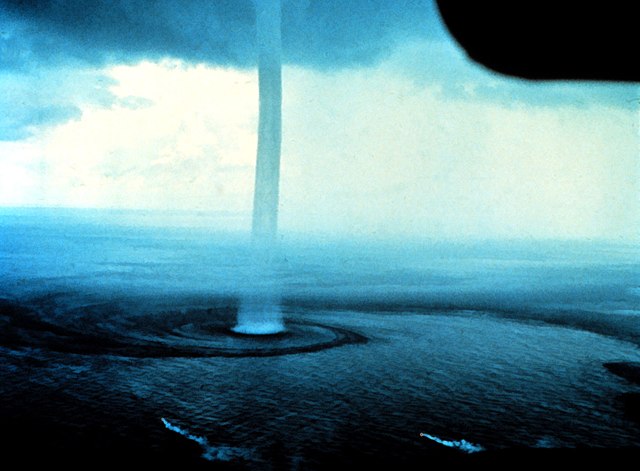 Image source: Wikipedia
Image source: Wikipedia
Tornadoes that happen on water are typically weaker than those happening on land. However, they can still damage boats and buildings near the water as well as injure people.
Myth #3: Heatwaves Only Happen in the Summer
Heatwaves can occur at any time of year, depending on weather patterns and climate conditions. Some parts of the world may even experience more frequent or severe heatwaves during seasons other than summer.
Heatwaves happen during a prolonged period of hot weather, often accompanied by high humidity and little to no relief at night. Many factors can cause these conditions, including high-pressure systems, warm ocean currents, and droughts. While summer is often associated with hot weather, heatwaves can take place during any season if the right weather conditions are present.
For example, in some regions, heat waves may happen more frequently in the spring or autumn. This is when temperatures are still warm but not quite as hot as in the summer. In other areas, heat waves may occur during the winter months due to warm air masses moving in from the tropics. For example, in 2023, Europe saw a record-breaking winter heatwave, with temperatures 10℃ to 15℃ warmer than average for this time of year. In some cases, human activities, such as urbanization and climate change, can also lead to heatwaves.
The table below summarizes the greatest heatwaves of the year 2022, some of which occurred not only in summer:
| Month | Location | Temperatures |
|---|---|---|
| February | USA, California | 75 °F (24 °C) |
| March-April | India | 120°F (49 °C) |
| May | USA, Baltimore | 95 °F (35 °C) |
| June | USA, St. Louis | 101 °F (38 °C) |
| June | Japan | 104 °F (40 °C) |
| July | Portugal | 116 °F (47 °C) |
| July | The UK | 104 °F (40 °C) |
It’s important to stay cool and hydrated during periods of hot weather, regardless of the season. This may include staying indoors in air-conditioned spaces, drinking plenty of water, and avoiding hard work during the hottest parts of the day.
Myth #4: Hurricanes Only Occur During Hurricane Season
The myth that hurricanes hit our planet only during hurricane season is a common one, but it’s not entirely true. While the Atlantic hurricane season typically runs from June 1 to November 30, hurricanes can form at any time of the year. However, off-season hurricanes do not typically exceed Category 2 and rarely result in deaths. The exception is Amanda, a Category 2 hurricane, which occurred in Florida on May 24-29, 1863, and took away 110 lives.
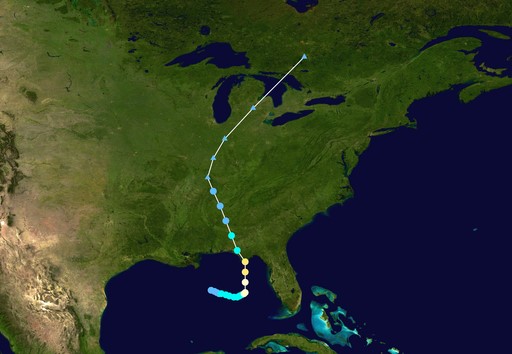 Image source: Wikimedia Commons
Image source: Wikimedia Commons
Hurricane season helps you get ready and watch out for storms, but hurricanes and tropical storms can happen anytime. Knowing when does a hurricane season start is always a good idea regardless of the time of year.
Myth #5: Heavy Rainfall Is the Only Reason for Flooding
One of the flooding myths is that only heavy rain can cause flooding. While it is true that heavy rainfall can contribute to flooding, it is not the only cause. Melting snow, storm surges, and dam or levee failures can also cause flooding. For example, if a snowpack melts rapidly, it can create a significant amount of runoff that can overwhelm rivers and other bodies of water. Similarly, storm surges resulting from hurricanes or other severe weather events can lead to flooding in coastal areas.
Furthermore, flash flooding can take place in areas with relatively low rainfall if the ground is already saturated. When even small storms or just humid air fill the ground with water, it can’t take more rain. More precipitation on the already-saturated ground can quickly lead to flash flooding, even if the rainfall is not particularly heavy.
Myth #6: A Green Sky Means a Tornado Is Coming
Among many tornado myths is the one that the green sky is a sign that a tornado will soon be there. While it is true that a greenish tint to the sky can indicate severe weather, it does not necessarily mean that a tornado is coming. Sunlight filtering through the clouds and reflecting off the water droplets in the air cause the green color of the sky. The more water droplets, the stronger the green tint.
In some cases, a green sky can mean a strong thunderstorm with hail, but not always a tornado. The green color results from the same process that creates hail in thunderstorms: water droplets are lifted high by strong updrafts.
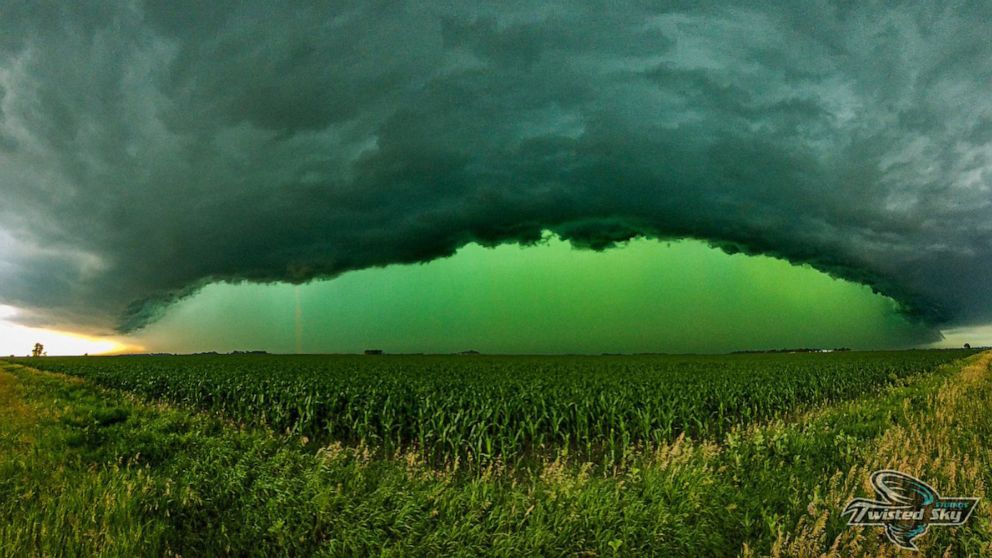 Image source: ABC News, Nathen Erickson/@TwstdSkyStudios via Twitter
Image source: ABC News, Nathen Erickson/@TwstdSkyStudios via Twitter
Therefore, while a green sky can mean severe weather, it is important to rely on weather safety tips from local authorities and severe weather warnings. This can include watching for rotating clouds, listening for sirens, checking out severe weather alerts in RainViewer, and following local news.
Myth #7: The Eye of a Hurricane Is Always Calm
The eye of a hurricane is a region of relative calm at the center of the storm. In this area, the winds are light, and the skies are often clear or only partly cloudy. This calm region is surrounded by the eyewall, which is the region of the storm with the most intense winds and heaviest precipitation.
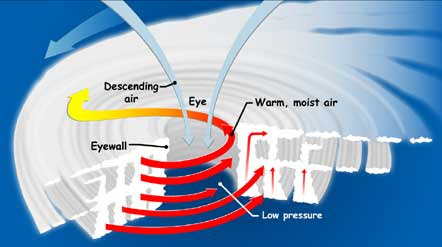 Image source: NASA
Image source: NASA
However, while the eye of a hurricane is typically calm, it’s not always the case. The size and shape of the eye can vary depending on the size and intensity of the storm. In some cases, the eye can be tiny. It means that it may only be calm for a short period of time before the eyewall moves back over the area. In other cases, wind shear or interaction with land can disrupt or distort the eye. As a result, the calm region can break up or disappear altogether. So hurricane myths about the calm eye are not always true.
Myth #8: You Can Easily Drive Through Flooded Roads
The myth that you can easily drive through flooded roads is dangerous because it can put both the driver and others at risk. In reality, this activity can be extremely hazardous and can lead to serious consequences, such as accidents and loss of life.
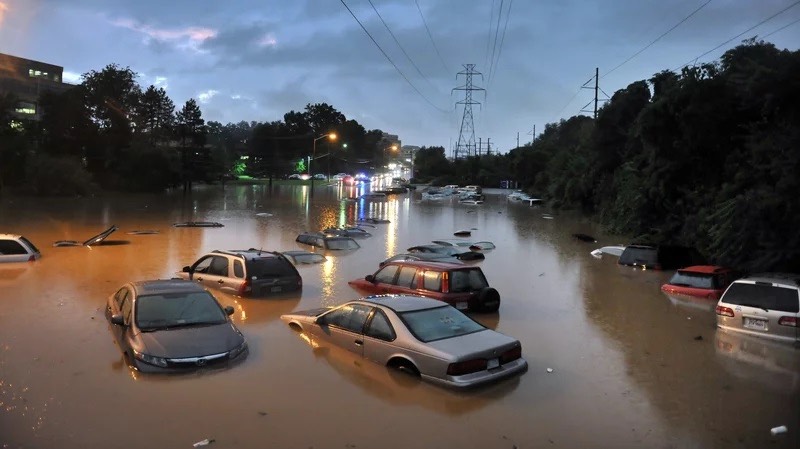 Image source: NPR, The Washington Post
Image source: NPR, The Washington Post
Driving through flooded roads can be dangerous for several reasons. Floodwaters can conceal debris or other hazards that can damage your vehicle or cause you to lose control. Additionally, floodwaters can be deeper than they appear. Even a small amount of water can be enough to stall your engine or cause your vehicle to become stuck. So if you come across a flooded road, turn around and find another route or wait until the water recedes.
Conclusion
Severe weather is a powerful natural force that can cause significant damage and harm. Understanding and debunking severe weather myths can contribute to your emergency preparedness. Remember to always rely on reliable sources for information about severe weather conditions and take the necessary precautions to protect yourself and your loved ones. Stay safe, and don’t let myths and misconceptions about severe weather put you in danger.






